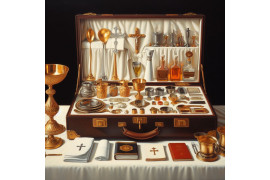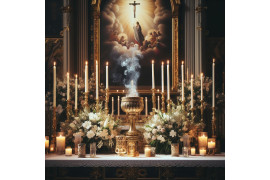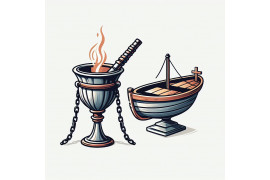Lamps hold significant symbolism in Christianity, as they are mentioned in various books of the Bible, including Exodus, Leviticus, and Revelation. These references highlight the association between lamps and light or illumination. In biblical texts, lamps are described as vessels containing oil or burning wicks. The concept of light is often used metaphorically to represent divine guidance, spiritual enlightenment, and the presence of God. Understanding the significance of lamps within a Christian context helps believers grasp their role in illuminating one's path towards righteousness and truth.
Throughout history, lamps have been a powerful symbol in religious practices and rituals. By shedding light on the darkness, lamps serve as a visual reminder of God's presence and guidance for believers. Exploring the biblical references to lamps provides insight into their more profound meaning within Christianity.
Significance of Lampstand as the Source of Light
The lamp stand holds great significance in Christianity, as it symbolizes God's presence and guidance through its role as a source of light. In the Bible, the lampstand is often referred to as the "golden lampstand" or "lamp stand," representing spiritual enlightenment and understanding.
One of the key functions of the lampstand was to provide continuous light in sacred spaces like the Tabernacle. It served as a physical representation of God's divine presence, illuminating the surroundings and dispelling darkness. The light emitted from the lampstand was seen as a metaphor for God's truth, wisdom, and guidance.
In Christian teachings, believers are encouraged to be like lamps that shine brightly in a world filled with darkness. The lampstand serves as a reminder that Christians should strive to live their lives in accordance with God's teachings, spreading love, kindness, and compassion to those around them.
The symbolism behind the lampstand goes beyond just providing physical light. It also represents spiritual illumination and understanding. Just as a lamp reveals what is hidden in darkness, God's presence brings clarity and reveals His truth to believers.
The image of a lamp also appears throughout other parts of Scripture. Jesus Himself refers to believers as "the light of the world" (Matthew 5:14), emphasizing their role in reflecting God's light to others. This further reinforces the idea that Christians are called to be sources of hope and inspiration in their communities.
The concept of light is deeply rooted in Christian theology. It signifies purity, righteousness, and salvation. In John 8:12, Jesus declares, "I am the light of the world." This statement highlights His role as the ultimate source of spiritual illumination for all believers.
Moreover, lamps were commonly used during biblical times for practical purposes such as lighting homes or guiding travelers at night. By using this familiar object as a symbol for God's presence, it made the concept of His guidance more relatable and accessible to people of that time.
Metaphorical Use of Lamps in the Bible
In Christianity, lamps are often used metaphorically to represent various concepts such as righteousness, wisdom, and salvation. These symbolic representations highlight the significance of light in the lives of believers and their responsibility to shine that light before others.
Representing Righteousness, Wisdom, and Salvation
Lamps in the Bible are frequently associated with righteousness, which refers to living a morally upright life according to God's commands. Just as a lamp illuminates a dark room, righteousness brings clarity and guidance to one's path. Proverbs 20:27 states, "The spirit of man is the lamp of the Lord, searching all his innermost parts." This verse emphasizes how God's Spirit within us serves as a guiding light.
Lamps symbolize wisdom. Psalm 119:105 declares, "Your word is a lamp to my feet and a light to my path." This verse illustrates how God's Word provides illumination and guidance in making wise decisions. It emphasizes the importance of seeking divine wisdom for navigating through life.
Furthermore, lamps represent salvation. In Matthew 25:1-13, Jesus tells the parable of ten virgins who were waiting for the bridegroom. Five were wise and carried extra oil for their lamps, while five were foolish and did not have enough oil. When the bridegroom arrived at midnight, only those with sufficient oil could enter into his wedding feast. This parable teaches that believers must be prepared for Christ's return by keeping their spiritual lamps filled with faith and readiness.
Shining Light Before Others
Believers are called to shine their light before others, just as lamps illuminate darkness. In Matthew 5:14-16, Jesus says, "You are the light of the world... Let your light shine before others so that they may see your good works." This passage highlights Christians' responsibility to live out their faith in a way that positively impacts those around them. By demonstrating love, kindness, and compassion, believers become beacons of light in a world filled with darkness.
Jesus as the Light of the World
Jesus referred to himself as "the light of the world" in relation to lamps. In John 8:12, he declares, "I am the light of the world. Whoever follows me will not walk in darkness, but will have the light of life." This statement emphasizes that Jesus is the ultimate source of spiritual illumination and salvation. Just as lamps dispel darkness, Jesus brings hope and eternal life to those who follow him.
Importance of Detail and Specification in Scripture
The lampstand holds great significance in Christianity, as it symbolizes God's presence and guidance. The specific instructions given for constructing the lampstand highlight God's attention to detail. In the Bible, every aspect of the lampstand is described meticulously, from its shape to its ornamentation. This emphasis on detail serves a purpose beyond mere aesthetics.
Detailed descriptions in scripture serve to emphasize the significance placed on symbolism within the text. By providing precise instructions for constructing the lampstand, God conveys His desire for His people to pay close attention to every aspect of their faith. Just as each component of the lampstand has a purpose and meaning, so too does every word and passage in the Bible.
Understanding these details helps uncover more in-depth meanings behind biblical passages. By examining the intricate design of the lampstand, we can gain insight into God's character and intentions. For example, one interpretation suggests that the seven branches of the lampstand represent completeness or perfection, reflecting God's all-encompassing power and wisdom.
By delving into these specifics, we can better comprehend and apply biblical teachings to our lives. The lampstand serves as a reminder that our faith should not be superficial but grounded in a thorough understanding of scripture. When we study scripture with attention to detail, we can uncover layers of meaning that might otherwise go unnoticed.
In addition to highlighting symbolism within scripture, detailed descriptions also provide evidence for the authenticity and reliability of biblical texts. The level of specificity found in these passages demonstrates an author who was intimately familiar with both practical craftsmanship and spiritual symbolism.
This attention to detail lends credibility to claims made within biblical texts by showcasing an accurate portrayal of historical events or practices. It provides readers with tangible evidence that supports their faith and helps them navigate through complex theological concepts.
Furthermore, understanding these details can deepen our appreciation for other aspects of Christian tradition and worship. For example, when we recognize how the lampstand was an essential part of the tabernacle and later the temple, we can better comprehend the significance of lighting candles in churches today. These practices connect us to our spiritual heritage and reinforce our sense of community with believers throughout history.
Understanding the Holy Spirit's Roles and Imagery
The Holy Spirit plays a significant role in Christianity, often symbolized by fire and lamps. Let's explore how these images relate to the believers' spiritual journey.
The Holy Spirit as Fire
In Christianity, the Holy Spirit is frequently associated with fire. This imagery can be connected to the flames of lamps, which illuminate darkness and provide warmth. Just as fire brings light and heat, the Holy Spirit brings guidance and comfort to believers.
Relying on the Holy Spirit for Spiritual Sustenance
Lamps require oil to fuel their flames, allowing them to shine brightly. Similarly, believers rely on the Holy Spirit for their spiritual sustenance. The Holy Spirit empowers individuals with strength, wisdom, and understanding of God's Word. It is through this divine connection that believers find nourishment for their souls.
Guided by Truth and Illuminated Paths
The Holy Spirit serves as a guide for believers, leading them towards truth and righteousness. Like a lamp shining in darkness, the Holy Spirit illuminates their path and helps them navigate through life's challenges. Through prayer and seeking guidance from the Holy Spirit, believers can find direction in making important decisions.
Examples of Lamp Imagery in Scripture
Throughout the Bible, there are numerous references to lamps that provide context for understanding its significance in relation to the Holy Spirit:
-
In Psalm 119:105 (NIV), it says: "Your word is a lamp for my feet, a light on my path." This verse highlights how God's Word acts as a guiding light in our lives.
-
In Matthew 25:1-13 (NIV), Jesus tells a parable about ten virgins with lamps waiting for the bridegroom. This story emphasizes preparedness and readiness for Christ's return.
-
In Revelation 4:5 (NIV), John describes heavenly visions were seven lamps are burning before the throne of God. This imagery symbolizes the presence and power of the Holy Spirit.
The Lamp's Symbolism for Believers
The lamp's symbolism in Christianity extends beyond its association with the Holy Spirit. It also represents believers as individuals who carry the light of Christ within them. Just as a lamp brightens a room, believers are called to shine their light in the world, spreading love, kindness, and hope to those around them.
Placement of the Lampstand in the Tabernacle's Holy Place
The lampstand, also known as the menorah, held a significant position within the Tabernacle's holy place. It was carefully placed opposite the table of showbread, ensuring that it provided light specifically for the priests during their duties.
This strategic placement had both practical and symbolic implications. On a practical level, the lampstand illuminated the holy place, allowing the priests to carry out their various tasks effectively. The priests needed proper lighting to perform their sacred duties, such as offering sacrifices and tending to the altar.
Symbolically, the positioning of the lampstand represented God's desire for His people to walk in His divine illumination. In Christianity, light often symbolizes God's presence and guidance. Just as physical light dispels darkness and provides clarity, spiritual light represents God's truth and wisdom, illuminating our path.
The lampstand served as a reminder that God wanted His people to live in His divine light and follow His ways. It emphasized the importance of seeking spiritual enlightenment through prayer, meditation on scripture, and living according to God's commandments.
In Psalm 119:105 (NIV), it is written: "Your word is a lamp for my feet, a light on my path." This verse highlights how God's Word acts as a guiding light in our lives. By positioning the lampstand opposite the table of showbread - which represented sustenance from God - it conveyed that true nourishment comes from walking in God's divine illumination.
Furthermore, throughout biblical history, lamps were used ceremonially during significant events. For instance, Samuel anointed David as king by pouring oil over his head while standing before a lamp (1 Samuel 16:13). The use of lamps during ceremonies signified divine favor and anointing upon individuals or objects.
The lampstand itself consisted of several components - seven branches with lamps at each end, a central shaft, and decorative almond blossoms. The lamps were fueled by olive oil, with the priests responsible for ensuring they remained lit continuously.
The lampstand's design held spiritual significance as well. The seven branches represented completeness or perfection, symbolizing the fullness of God's light shining upon His people. The almond blossoms on the lampstand were a reminder of Aaron's rod that budded (Numbers 17:8), signifying God's chosen priesthood.
Insights on the Lamp in Christianity
In exploring the lamp in Christianity, we have discovered its profound significance as a source of light. The lampstand, positioned in the Holy Place of the Tabernacle, symbolizes illumination and guidance. Metaphorically, lamps are frequently used in the Bible to represent God's Word and His truth shining upon humanity. It is crucial to note that Scripture often provides intricate details and specifications regarding the lampstand, emphasizing the importance of precision and attention to divine instructions.
Understanding the roles and imagery associated with the Holy Spirit is key when comprehending the lamp's symbolism in Christianity. The Holy Spirit serves as a guiding light, illuminating our path and revealing God's truth to us. By studying these insights on lamps in Christianity, one can gain a more in-depth understanding of their spiritual significance and embrace them as a call to seek divine enlightenment.
To further your understanding of Christian symbolism and its relevance today, delve into related topics such as biblical interpretations of light, additional metaphors used throughout Scripture, or explore how different denominations interpret this symbolism within their worship practices. May your journey towards spiritual enlightenment be filled with illumination and discovery.
FAQs
What other symbols are commonly used in Christianity?
Christianity employs various symbols that hold significant meaning for believers worldwide. Some commonly recognized symbols include the cross (representing Jesus' sacrifice), fish (a symbol used by early Christians), dove (symbolizing peace and the Holy Spirit), Alpha and Omega (referring to Christ's eternal nature), and many more. These symbols serve as visual reminders of core Christian beliefs.
How can I deepen my understanding of Christian symbolism?
To deepen your understanding of Christian symbolism, consider studying biblical texts that discuss these symbols directly or indirectly. Exploring theological commentaries or consulting knowledgeable individuals within your faith community can provide valuable insights. Engaging in discussions or attending seminars focused on religious art or iconography may also enhance your understanding of Christian symbolism.
Are there any denominational differences in the interpretation of lamp symbolism?
While the lamp's symbolism as a source of light and guidance is generally consistent across Christian denominations, variations may exist in how different groups interpret and emphasize this symbolism. It is advisable to consult specific denominational teachings or engage in discussions with theologians from various traditions to gain a comprehensive understanding of their perspectives on lamp symbolism.
Can lamps be used as physical symbols within Christian worship practices?
Yes, lamps can be used as physical symbols within Christian worship practices. Some churches incorporate candle lighting ceremonies or use oil lamps during specific religious rituals. These practices serve as tangible representations of the spiritual concepts associated with lamps, such as illumination, prayer, and the presence of the Holy Spirit.
How can I apply the insights on lamp symbolism in my personal spiritual journey?
To apply the insights on lamp symbolism in your personal spiritual journey, consider incorporating moments of reflection and meditation upon these symbolic meanings. Seek to deepen your understanding by studying relevant biblical passages and connecting them with your own experiences. Embrace the call to seek divine enlightenment through prayer, seeking wisdom from trusted spiritual mentors, and actively pursuing a life guided by God's truth and illumination.



